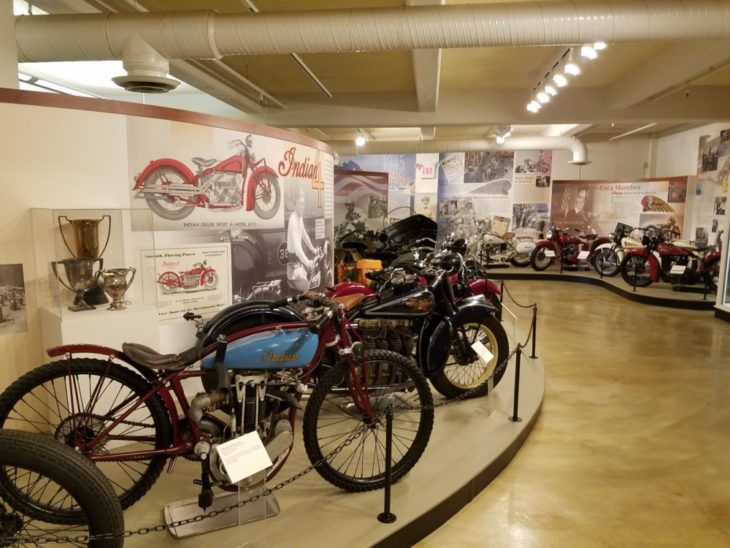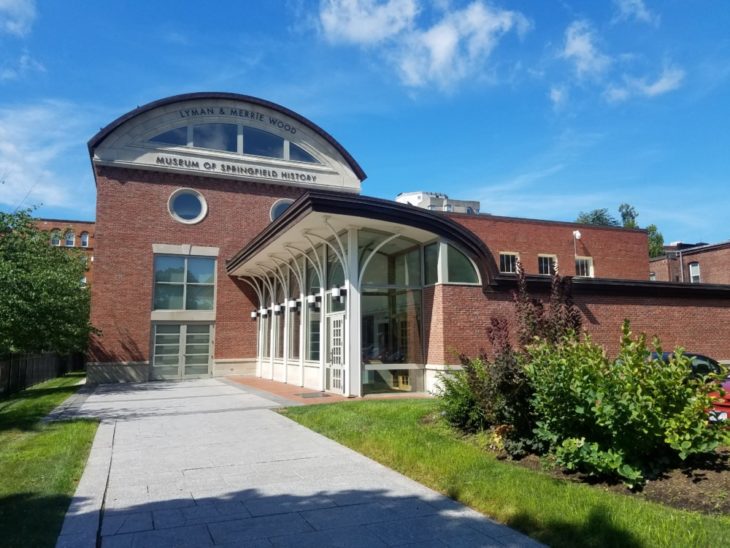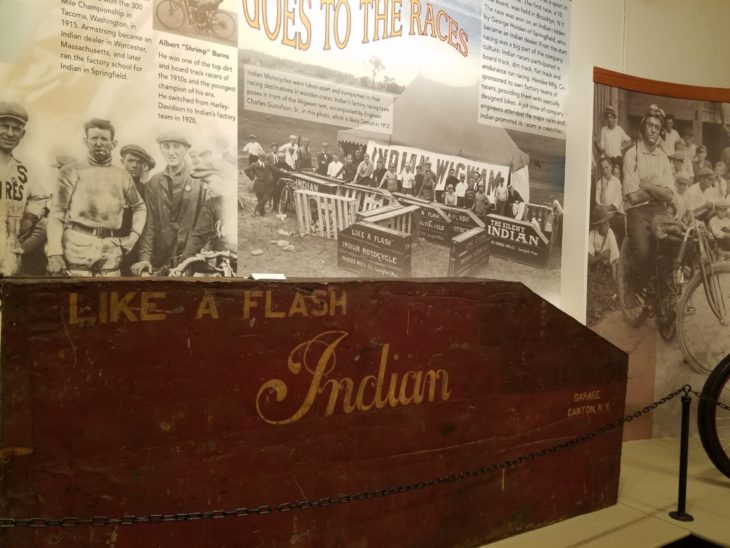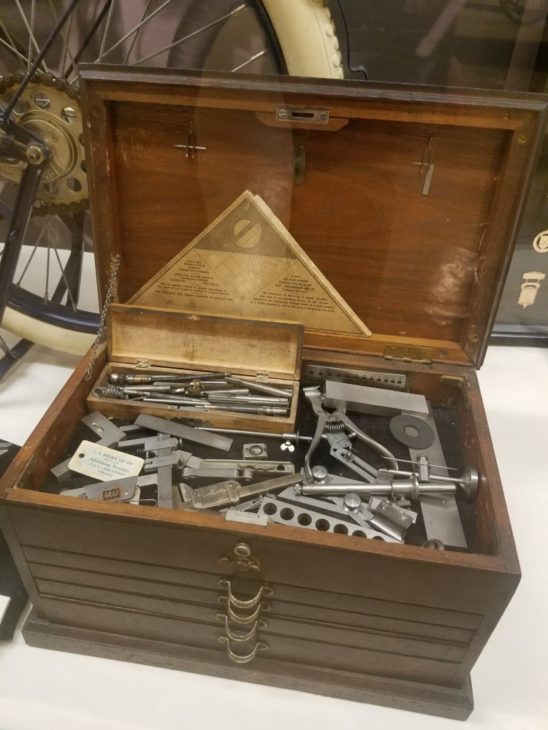Larry Lawrence | August 14, 2018
Archives: Seeing Indian’s History
Early 2000s. I was in the area doing advance media work for the Southwick AMA Motocross National in Hartford, Connecticut and later Springfield, Massachusetts. After we’d done our stops at the TV and radio stations in Springfield, the rider I was working with, John Dowd headed off to the track. I meanwhile made a beeline to the Indian Motocycle Museum, which was located on site of the old Indian Motorcycle factory. I walked into the small out building, one of the few remaining structures of the old Indian factory complex, and my eyes opened wide. Surrounding me were dozens of historic Indian motorcycles dating back to the first decade of its existence, as well as all kind of other factory and Indian memorabilia. Old black and white photos of workers assembling Indians hung on the walls. I was in awe.
Archives: Seeing Indian’s History
 Just a small part of the wonderful selection of historic Indian motorcycles on display at the Springfield Museums in Springfield, Massachusetts. (Larry Lawrence photo)
Just a small part of the wonderful selection of historic Indian motorcycles on display at the Springfield Museums in Springfield, Massachusetts. (Larry Lawrence photo)
Just as I was getting my bearings after the assault of almost too much to take in all at once, I heard the voice of an elderly lady. To be completely honest it was a bit of an unexpected encounter, it could even be called slightly jarring. Instead of a welcoming tone and greeting, the old lady started hitting me with rapid-fire questions – “Who am I; Why am I here; What’s my interest in seeing these pieces of history?”
I guess that’s one way to get to know someone, don’t beat around the bush, get right to the point.
Once I told her I worked for AMA Pro Racing I think if anything her glare at me became even more suspecting. From that point I was subjected to all the grievances this lady ever held with the AMA and people who worked there. Keep in mind, this all happened within the first few minutes I walked in the door!
A sarcastic “Nice to meet you too ma’am,” was what I felt like saying, but I restrained myself.
I didn’t know it at the time, but the lady grilling me that day at the Indian Motocycle Museum was none other than Esta Manthos, co-founder (along with her husband Charlie) and president of the former Indian Motocycle Museum. Famously cantankerous, Esta was equally well-known and admired for keeping the history of Indian alive during a time when a lot motorcycle people didn’t really think that was all that important. When the museum was founded in 1974, it was well before the vintage motorcycle revival of the 1980s. Old bikes were considered just that. The percent of motorcycling folks who understood just how invaluable and historic the museum’s collection was, was minuscule.
 The Wood Museum, in Springfield, which now houses the Esta Manthos Indian Motocycle Collection. (Larry Lawrence photo)
The Wood Museum, in Springfield, which now houses the Esta Manthos Indian Motocycle Collection. (Larry Lawrence photo)
The couple of hours I spent in the museum that summer day I had the place all to myself. In retrospect Esta was simply being vigilant and making sure I had good intentions on my visit that day. After awhile some sort of truce was established and she opened up with great stories about Indian. Unfortunately, not knowing the importance of the lady I was talking with at the time, I didn’t have a recorder running.
Esta’s husband Charlie passed away in 1996. A professional metallurgist and ardent Indian Motocycle collector, Charlie had an entrepreneurial vision of bringing a new, locally manufactured Indian Motocycle back into production. Working with two former Indian employees, Earl “Pop” Armstrong and design engineer Jimmie Hill, he created a prototype based on the 1953 Indian Chief, the last of the original Indian production line. He hoped to take it to market in 1975 but his dream was never realized.
Charlie became a lifelong enthusiast for the Springfield-made cycles when he rode his first Indian as a young man in the 1930s. After decades of assembling a personal collection of Indian motorcycles and memorabilia he and Esta opened their own Indian Motocycle Museum in 1974. Knowing that Charlie wanted the Indian collection to stay intact and in Springfield, in 2007 Esta made a generous gift of the collection to the Springfield Museums.
“I’m very history- and civic-oriented,” Esta told The Springfield Republican in 2007, after donating their extensive collection of Indian motorcycles, artifacts and memorabilia to the Springfield Museums.
 An original Indian racing shipping crate. (Larry Lawrence photo)
An original Indian racing shipping crate. (Larry Lawrence photo)
She noted that the idea of splitting up the pricey collection to live out her life in riches had no appeal to her. “That is unimportant,” she added.
Thanks to Esta’s stewardship of the museum’s collection we are able to enjoy the collection today. Housed in The Wood Museum of Springfield History, part of the larger Springfield Museums complex, the museum’s Indian Motocycle Collection is the largest collection of Indian cycles and memorabilia in the world.
If you happen to be in the Springfield area the museum is well worth a visit. I’m fortunate that I was able to see the collection in its rawer form in the old museum and the spruced-up version today at its new home.
 The toolkit on display at the museum was owned and used by Indian co-founder Oscar Hedstrom. (Larry Lawrence photo)
The toolkit on display at the museum was owned and used by Indian co-founder Oscar Hedstrom. (Larry Lawrence photo)
Indian enthusiasts gather every year in the middle of the summer at the museum for “Indian Day”.
For 35 years, Indian Day was held in Springfield at the former Indian Motocycle Museum on Hendee Street. First held at that location in 1970, Indian Day provided an opportunity for Indian riders, collectors, and motorcycle enthusiasts to display their bikes, talk shop, swap parts, and compete for various awards. After a brief hiatus, Indian Day is once again an annual tradition in Springfield, held since 2010 on the grounds of the Springfield Museums.
It’s good to know that the history of what once was America’s largest motorcycle manufacturer was preserved by caring, and yes, at times and irascible old woman and now cherished by the city of Springfield and available to us all.